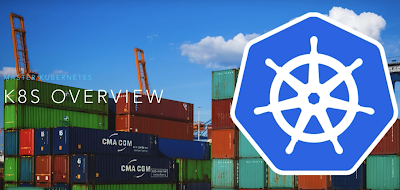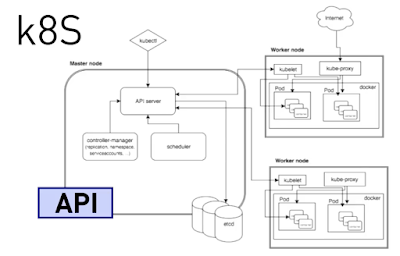A Brief on Containerization
Generally transporting goods involves packaging & shipping containers that move between different modes of transportation by different shipping companies to deliver your goods at the doorstep. critical business functions. Modern software techniques like microservices divide software applications into smaller independent functions that are build, packaged, scaled & managed independently as isolated containers. Containers can mentioned as operating system level virtualization method for running multiple isolated linux systems on a host with a single linux kernel.

Docker has become the de-facto standard for managing container images defined using Dockerfile, and allows that to run on any machine with Docker Install. However complex application require container orchestration solutions, like Kubernetes, that can manage the lifecycle of containers & how these containers communicate can each other.

Docker has become the de-facto standard for managing container images defined using Dockerfile, and allows that to run on any machine with Docker Install. However complex application require container orchestration solutions, like Kubernetes, that can manage the lifecycle of containers & how these containers communicate can each other.
A Brief on Kubernetes
 Kubernetes is an open source platform for managing containerized workloads & services. Kubernetes, with support from major cloud vendors, has emerged as the de-facto standard for container orchestration governed by Cloud Native Computing Foundation a.k.a CNCF. Kubernetes, born at Google, has a backing from large open source community has quite an advantage compared to other products like Docker Swarm, Apache Mesos.
Kubernetes is an open source platform for managing containerized workloads & services. Kubernetes, with support from major cloud vendors, has emerged as the de-facto standard for container orchestration governed by Cloud Native Computing Foundation a.k.a CNCF. Kubernetes, born at Google, has a backing from large open source community has quite an advantage compared to other products like Docker Swarm, Apache Mesos. Master node in a kubernetes cluster contains services to support the Rest API, scheduler & controller manager. Each cluster contain one or more worker node, which contain the components to communicate with master node & also manage the containers running on the node. Worker node run containers managed as a logical layer represented by Pod.
A Brief on MongoDB Ops Manager & Operator
Ops Manager 4.0 contains a specialized component called MongoDB Ops Manager Kubernetes operator, simply referred as Operator. Operator Implementation, now part of Kubernetes framework, is a continuously running lightweight process deployed as a Pod with single container.
Operator defines & registers the custom types within the Kubernetes cluster, which allows operator to receive notification about the events occurring on the registered types. Notifications such as object creation or object deletion allow Operator to trigger custom logic on Kubernetes tasks, such as add mongod replica set to the Ops Manager project. Operator essentially acts as a proxy between the Kubernetes & Ops Manager to perform the needed tasks against each system. Helm, which is a tool for managing packaging & deployment in Kubernetes, can be used to deploy an operator Pod with a helm chart.
Operator defines & registers the custom types within the Kubernetes cluster, which allows operator to receive notification about the events occurring on the registered types. Notifications such as object creation or object deletion allow Operator to trigger custom logic on Kubernetes tasks, such as add mongod replica set to the Ops Manager project. Operator essentially acts as a proxy between the Kubernetes & Ops Manager to perform the needed tasks against each system. Helm, which is a tool for managing packaging & deployment in Kubernetes, can be used to deploy an operator Pod with a helm chart.
Lab - Setup Kubernetes Cluster with MongoDB
Pre-requisite Step: Virtual Box, Docker, Kubectl, Minikube, Helm
Virtual Box: virtualbox --help
Docker: docker version
 Kubectl: kubectl version
Kubectl: kubectl versionMinikube: minikube version
Helm: helm version
Step: MiniKube
minikube start
minikube status
eval $(minikube docker-env) - This sets the shell environment variables so that docker points to the registry running inside the kubernetes cluster. Running docker images will list the kubernetes images deployed in the minikube cluster.
Lab - Kubernetes Operator
a) Create a MongoDB namespace.
Jeetans-MacBook-Pro:dirKubernetes home$ kubectl create namespace mongodb
namespace/mongodb createdb) Configure Kubectl to mongodb namespace
Jeetans-MacBook-Pro:dirKubernetes home$ kubectl config set-context $(kubectl config current-context) --namespace=mongodb
Context "minikube" modified.
Jeetans-MacBook-Pro:dirKubernetes home$ kubectl get all
No resources found.
d) Clone MongoDB-Enterprise-Kubernetes repository
Jeetans-MacBook-Pro:dirKubernetes home$ git clone https://github.com/mongodb/mongodb-enterprise-kubernetes
Cloning into 'mongodb-enterprise-kubernetes'...
remote: Enumerating objects: 21, done.
remote: Counting objects: 100% (21/21), done.
remote: Compressing objects: 100% (15/15), done.
remote: Total 132 (delta 8), reused 14 (delta 6), pack-reused 111
Receiving objects: 100% (132/132), 29.71 KiB | 2.29 MiB/s, done.
Resolving deltas: 100% (52/52), done.
Jeetans-MacBook-Pro:dirKubernetes home$ ls
mongodb-enterprise-kubernetes
d) Create a service account for helm
Jeetans-MacBook-Pro:dirKubernetes home$ kubectl create serviceaccount --namespace kube-system tiller
serviceaccount/tiller created
e) Create a cluster role binding for the account
Jeetans-MacBook-Pro:dirKubernetes home$ kubectl create clusterrolebinding tiller-cluster-rule --clusterrole=cluster-admin --serviceaccount=kube-system:tiller
clusterrolebinding.rbac.authorization.k8s.io/tiller-cluster-rule created
f) Initialize the helm system
Jeetans-MacBook-Pro:dirKubernetes home$ helm init --service-account tiller
Creating /Users/home/.helm
Creating /Users/home/.helm/repository
Creating /Users/home/.helm/repository/cache
Creating /Users/home/.helm/repository/local
Creating /Users/home/.helm/plugins
Creating /Users/home/.helm/starters
Creating /Users/home/.helm/cache/archive
Creating /Users/home/.helm/repository/repositories.yaml
Adding stable repo with URL: https://kubernetes-charts.storage.googleapis.com
Adding local repo with URL: http://127.0.0.1:8879/charts
$HELM_HOME has been configured at /Users/home/.helm.
Tiller (the Helm server-side component) has been installed into your Kubernetes Cluster.
Please note: by default, Tiller is deployed with an insecure 'allow unauthenticated users' policy.
To prevent this, run `helm init` with the --tiller-tls-verify flag.
For more information on securing your installation see: https://docs.helm.sh/using_helm/#securing-your-helm-installation
Happy Helming!
g) Create a secret & verify it with describe command.
$ kubectl -n mongodb create secret generic my-credentials --from-literal="user=some@example.com" --from-literal="publicApiKey=my-public-api-key"
secret/madajeeblog-credentials created
Jeetans-MacBook-Pro:dirKubernetes home$ kubectl describe secrets/madajeeblog-credentials -n mongodb
Name: madajeeblog-credentials
Namespace: mongodb
Labels: <none>
Annotations: <none>
Type: Opaque
Data
====
publicApiKey: 36 bytes
user: 21 bytes
i) Install the operator with helm chart.
Jeetans-MacBook-Pro:mongodb-enterprise-kubernetes home$ helm install helm_chart/ --name mongodb-enterprise
NAME: mongodb-enterprise
LAST DEPLOYED: Sun Nov 18 09:33:07 2018
NAMESPACE: mongodb
STATUS: DEPLOYED
RESOURCES:
==> v1/ServiceAccount
NAME AGE
mongodb-enterprise-operator 1s
==> v1beta1/CustomResourceDefinition
mongodbstandalones.mongodb.com 1s
mongodbreplicasets.mongodb.com 1s
mongodbshardedclusters.mongodb.com 1s
==> v1/Role
mongodb-enterprise-operator 1s
==> v1/RoleBinding
mongodb-enterprise-operator 1s
==> v1/Deployment
mongodb-enterprise-operator 1s
==> v1/Pod(related)
NAME READY STATUS RESTARTS AGE
mongodb-enterprise-operator-74fbcbd9b7-p944v 0/1 ContainerCreating 0 1s
i) Operator is up & running.
Jeetans-MacBook-Pro:mongodb-enterprise-kubernetes home$ kubectl get all
NAME READY STATUS RESTARTS AGE
pod/mongodb-enterprise-operator-74fbcbd9b7-p944v 1/1 Running 0 9m
NAME DESIRED CURRENT UP-TO-DATE AVAILABLE AGE
deployment.apps/mongodb-enterprise-operator 1 1 1 1 9m
NAME DESIRED CURRENT READY AGE
replicaset.apps/mongodb-enterprise-operator-74fbcbd9b7 1 1 1 9m
Jeetans-MacBook-Pro:mongodb-enterprise-kubernetes home$
Lab - MongoDB Ops Manager
a) Simple Test Ops Manager - Deployment with one pod with container running a mongoDB instance for Ops Manager application DB, another container running an instance of Ops Manager.
Jeetans-MacBook-Pro:dirKubernetes home$ curl -OL https://raw.githubusercontent.com/jasonmimick/mongodb-openshift-dev-preview/master/simple-test-opsmanager-k8s/simple-test-opsmgr.yaml
% Total % Received % Xferd Average Speed Time Time Time Current
Dload Upload Total Spent Left Speed
100 3228 100 3228 0 0 14934 0 --:--:-- --:--:-- --:--:-- 14944
b) Use kubectl & downloaded yaml configuration to create an instance of Ops Manager.
Jeetans-MacBook-Pro:dirKubernetes home$ kubectl create -f simple-test-opsmgr.yaml
persistentvolume/mongodb-opsmgr-appdb-pv-volume created
persistentvolumeclaim/mongodb-opsmgr-appdb-pv-claim created
persistentvolume/mongodb-opsmgr-config-pv-volume created
persistentvolumeclaim/mongodb-opsmgr-config-pv-claim created
secret/mongodb-opsmgr-global-admin created
service/mongodb-opsmgr created
deployment.apps/mongodb-opsmgr created
c) Ops Manager is up & running.
Jeetans-MacBook-Pro:dirKubernetes home$ kubectl get all
NAME READY STATUS RESTARTS AGE
pod/mongodb-enterprise-operator-74fbcbd9b7-p944v 1/1 Running 0 5h
pod/mongodb-opsmgr-8c44d98f8-97jvs 0/2 Running 0 1m
NAME TYPE CLUSTER-IP EXTERNAL-IP PORT(S) AGE
service/mongodb-opsmgr NodePort 10.100.253.9 <none> 8080:30080/TCP 1m
NAME DESIRED CURRENT UP-TO-DATE AVAILABLE AGE
deployment.apps/mongodb-enterprise-operator 1 1 1 1 5h
deployment.apps/mongodb-opsmgr 1 1 1 0 1m
NAME DESIRED CURRENT READY AGE
replicaset.apps/mongodb-enterprise-operator-74fbcbd9b7 1 1 1 5h
replicaset.apps/mongodb-opsmgr-8c44d98f8 1 1 0 1m
Jeetans-MacBook-Pro:dirKubernetes home$
d) Create a mongoDB replica set config file with appropriate project, credentials & namespace.
e) Run the config file to create a replica set which have mongod container pod as its members. Container Pods will be associated with the Stateful Sets.
f) You can then connect to the mongoDB replica set with the minikube IP & exposed external port from a kubernetes replica set service.
Thanks



No comments:
Post a Comment